Mother Nature has blessed us with some stunning blooms, each more enchanting than the last. From vibrant colors to delicate petals, these gorgeous flowers are sure to take your breath away. We have curated a list of the most exquisite flowers that start with E, sure to add to any garden or bouquet.
So let’s explore the beautiful world of flowers that start with E and discover their captivating charm!
1. Easter Lily (Lilium longiflorum)
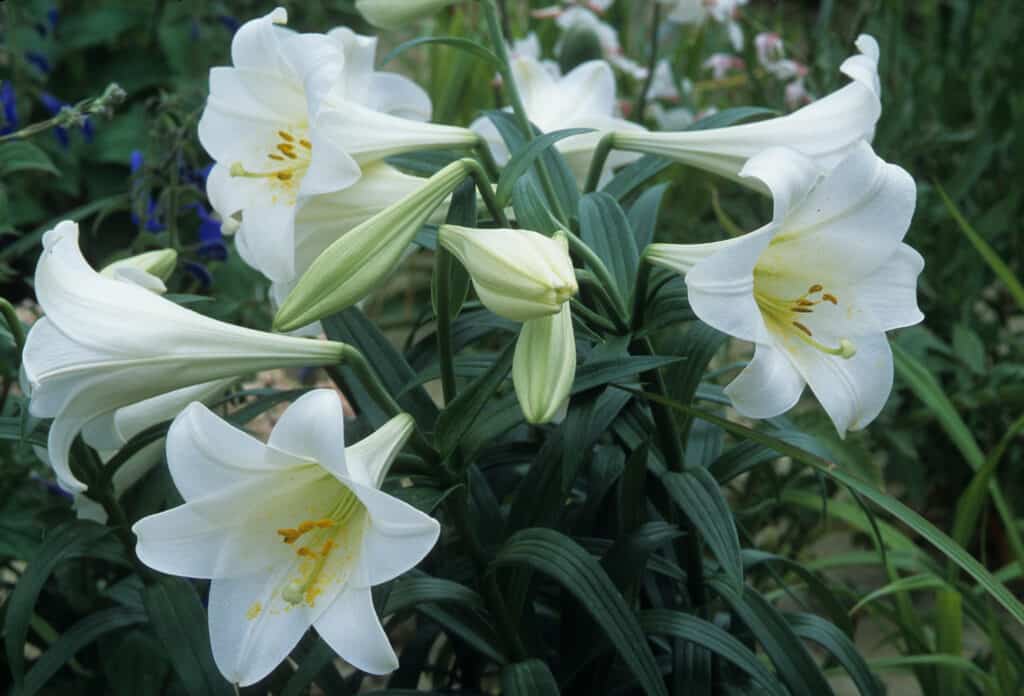
The Bible references the white flowers of the Easter lily.
©COULANGES/Shutterstock.com
Easter lilies, renowned for their beauty and sweet fragrance, grace homes and churches during the Easter season. Of course, these stunning blooms hold a special place in Christianity and are even referenced in the Bible.
With their elongated, tubular flowers measuring 3-7 inches in length, they gracefully form a trumpet-like shape, captivating all who behold them. While the Easter lily cultivars commonly sold in containers boast pristine white petals, variations of pink, yellow, and cream can be found within this species as well.
Typically blooming in late spring to early summer, these flowers only last a few days.
2. Edelweiss (Leontopodium nivale)

Thriving in remote areas of the Alps, the edelweiss blooms from July to September.
©nomadphotography/Shutterstock.com
The edelweiss bloom symbolizes unwavering devotion, owing to its ability to flourish in the harshest alpine conditions. Thriving amidst the most remote and challenging areas of the Swiss, German, and Austrian Alps, this delicate yet resilient flower exudes a sense of determination.
Clusters of 2 to 10 yellow flower heads are nestled amid lance-shaped, woolly, white leaves that form a star-like arrangement. Additionally, edelweiss finds its home in limestone soil, gracing mountain meadows at elevations ranging from 6,000 to 10,000 feet.
From July to September, these enchanting blooms dot the alpine landscape.
3. Egyptian Star Cluster (Pentas lanceolata)

Another beautiful flower that starts with E is the Egyptian star cluster.
©topimages/Shutterstock.com
Egyptian star cluster, known for attracting essential pollinators like honeybees, butterflies, and hummingbirds, has become a beloved addition to gardens. However, it’s important to remain vigilant, as these vibrant blooms can also draw spider mites that may threaten other flowers in your garden.
The Egyptian star cluster, a native perennial found across Southern Arabia to tropical East Africa, showcases glossy dark green elliptic leaves in clustered arrangements. They also boast bright star-shaped flowers that come in a range of colors, including red, pink, lavender, or white.
This ornamental plant is perfect for creating eye-catching flowerbeds when grown in abundance. Blooming during the summer, its blossoms serve as long-lasting cut flowers.
4. Eglantine Rose (Rosa rubiginosa)

Queen Elizabeth I adopted the eglantine rose as a symbol of royalty.
©marineke thissen/Shutterstock.com
The eglantine rose, cherished by Queen Elizabeth I of England and cultivated even before 1551, holds a special place in English history. Markedly, the Queen adopted this wild rose as a symbol of royalty and purity.
Eglantine roses boast sprawling growth, showcasing large, single pale pink flowers that grace gardens in late spring and early summer. Furthermore, the sweet aroma of apples permeates the air as their petals unfold. The rose hips of the eglantine variety are also highly sought after for making tea.
To manage its long, thorny canes, this rose can be trained to grow on posts or trellises.
5. English Bluebell (Hyacinthoides non-scripta)
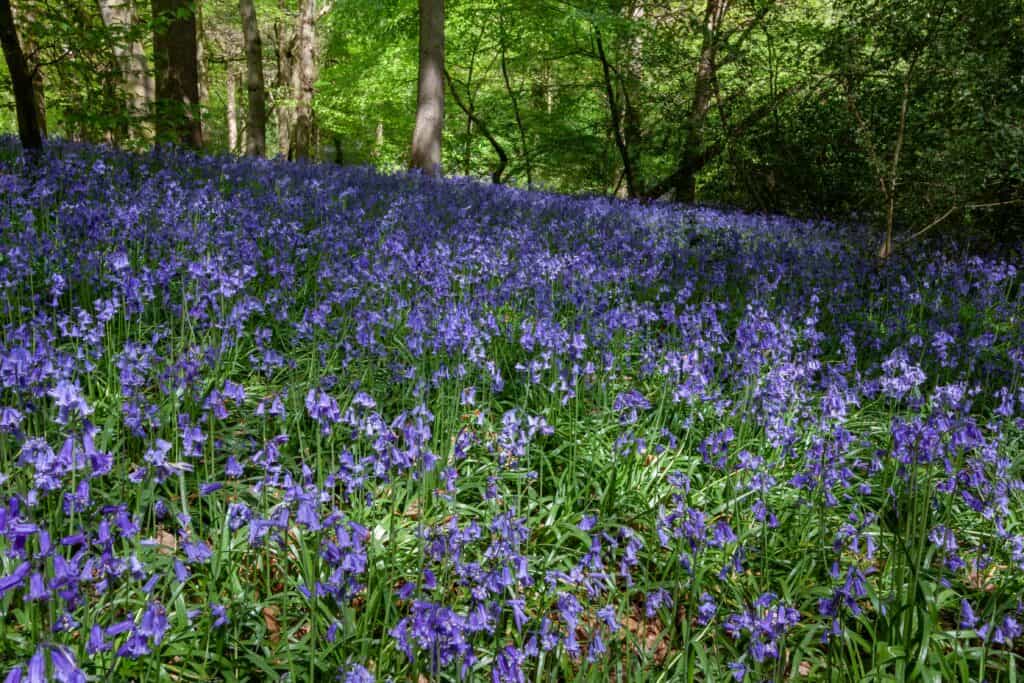
The English bluebell has bell-shaped flowers.
©Philip Bird LRPS CPAGB/Shutterstock.com
The bluebell signifies gratitude, humility, and eternal love. Additionally, legends speak of the bluebell’s mystical power, as it is believed that turning its delicate flower inside-out, without causing harm, can help one win the heart of their beloved.
English bluebells are graceful in appearance, with their slender, bell-shaped flowers adorned with gently curled petals. Furthermore, most of these blooms droop from one side of the stem. These flowers also have creamy-white anthers and slender leaves, typically measuring between ¼ to ¾ inch in width.
English bluebells grace us with their captivating beauty from late March to early May, and they are one of the last spring flowers to bloom.
6. English Daisy (Bellis perennis)

The English daisy is native to Europe.
©M9K/Shutterstock.com
Folklore reveals that the daisy carries many meanings, symbolizing simplicity, innocence, happiness, new beginnings, good luck, and purity.
The English daisy, a member of the daisy family, is a charming flower native to Europe. Unique in structure, the flower stems surprisingly lack leaves and give rise to blooms adorned with a circular arrangement of white, pink, or red rays surrounding a sunny yellow center.
Bringing an early burst of color to gardens, these daisies generally bloom in March and April. Notably, their petals close during the evening hours, only to unfurl with the first rays of morning, making them among the first to greet the rising sun each day.
7. English Lavender (Lavandula angustifolia)
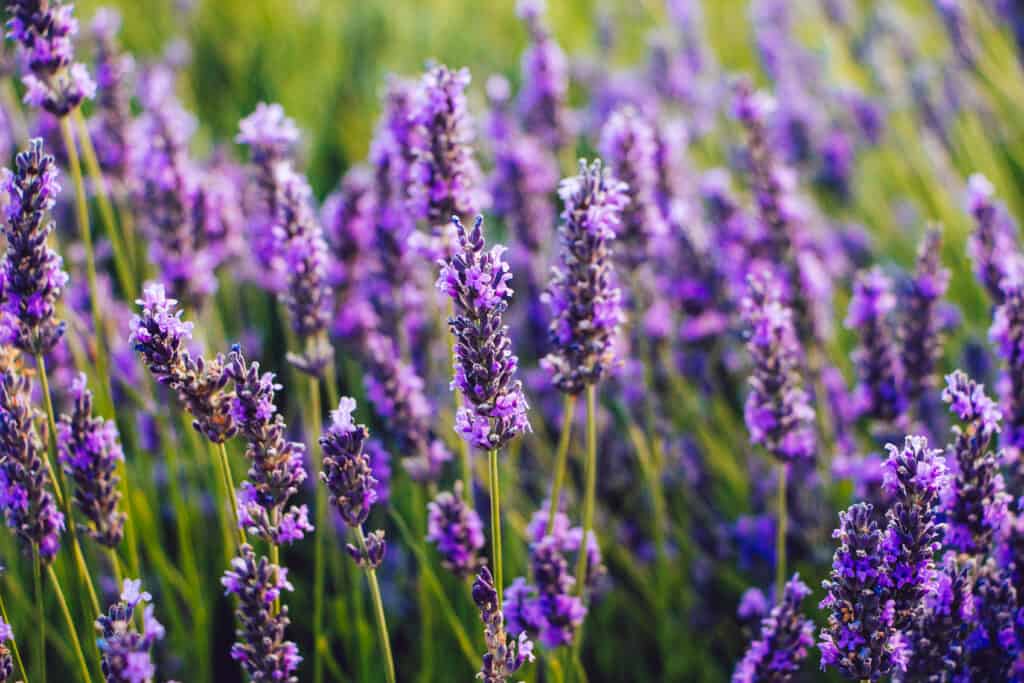
English lavenders are actually native to the Mediterranean.
©iStock.com/ASIFE
Lavender flowers embody silence, purity, devotion, grace, serenity, and calmness.
Surprisingly, this flower is not native to England but rather the Mediterranean region. When brushed or crushed, English lavender releases a delightful fragrance that fills the air. Additionally, its upright stems proudly display wispy inflorescences.
Cultivars now offer a range of shades from blue-purple and lavender to violet-blue or white-pink. The blooming season starts in early to mid-summer and lasts approximately 3-4 weeks.
8. English Marigold (Calendula officinalis)
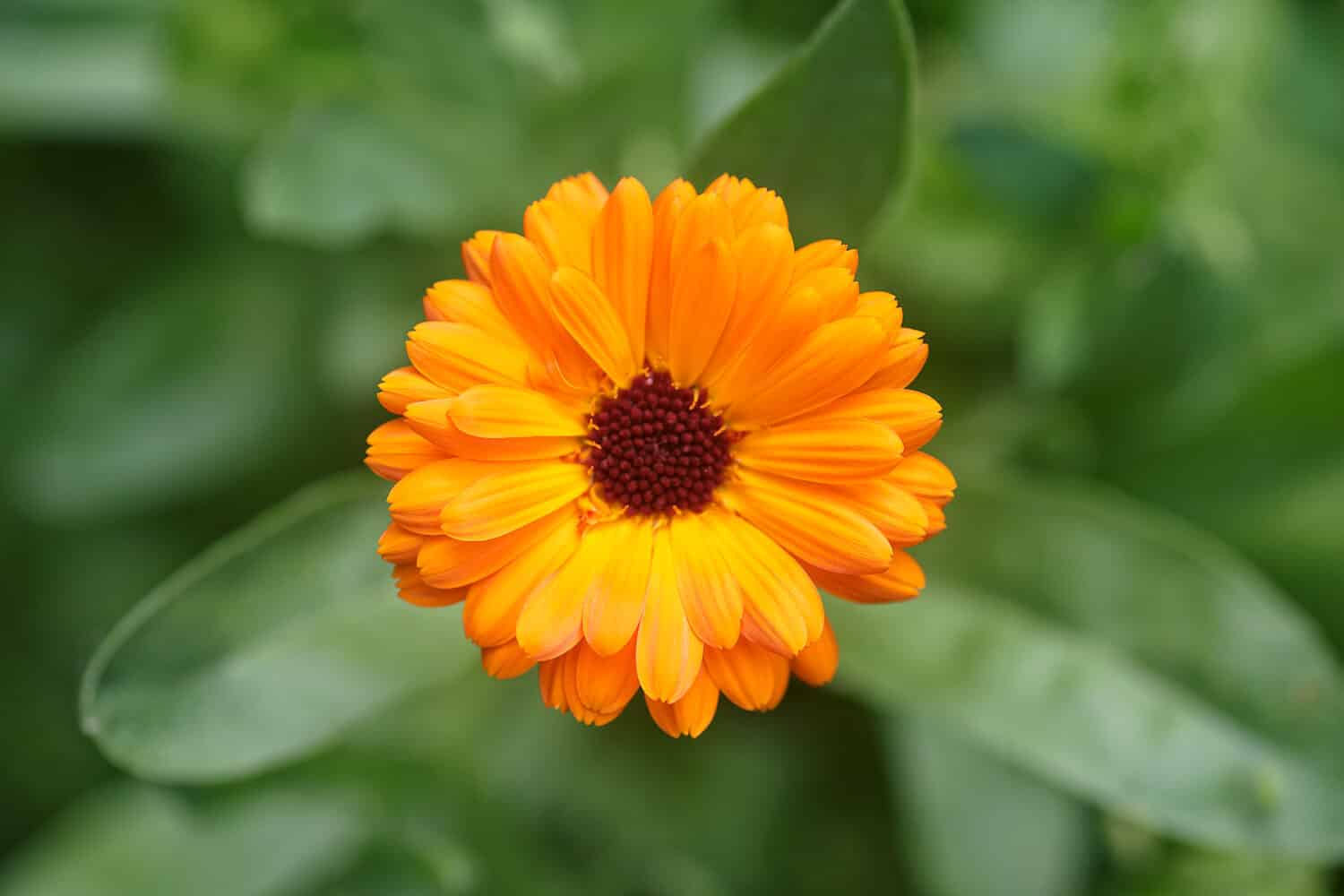
The English marigold comes in many inflorescence shapes.
©domnitsky/Shutterstock.com
Marigolds have a rich history, and the English marigold, although unrelated to the Mexican genus, carries the same symbolism, such as grief and mourning.
With their vibrant presence, English marigolds offer various inflorescence shapes, including pom-pom, anemone, and daisy-like forms. These captivating blooms also display a wide range of colors, spanning from sunny yellow and golden hues to warm shades of orange, red, and rich mahogany.
With their reliable blooming from late spring or early summer until the first frost in late fall, marigolds bring continuous bursts of color and beauty to the landscape.
9. English Primrose (Primula vulgaris)
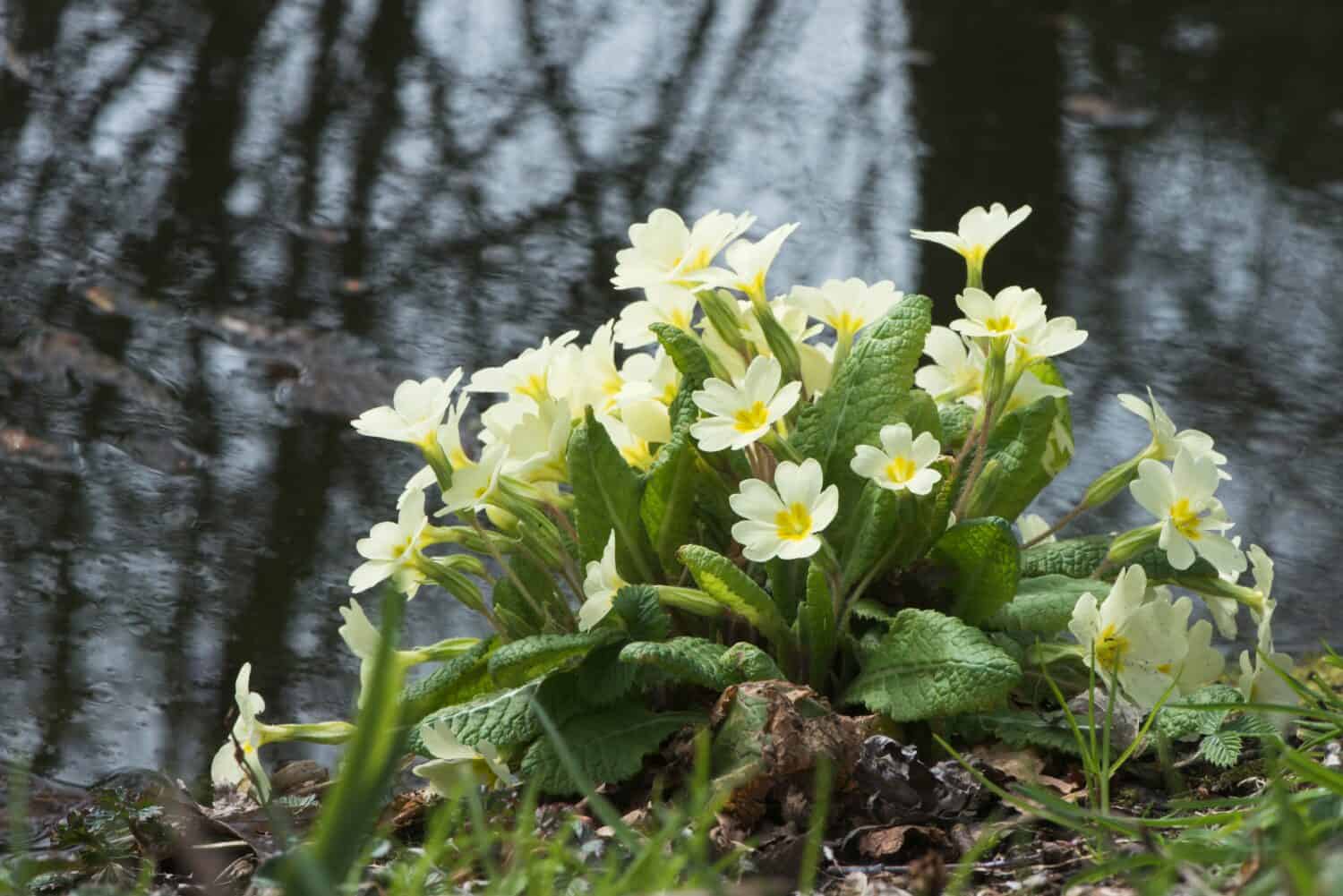
One of the earliest blooming flowers that start with E is the English primrose.
©imageBROKER.com/Shutterstock.com
The English primrose is one of the earliest blooming flowers, earning its name from the Latin word “primus,” meaning “first.”
Pale yellow in color, each flower has a deeper yellow or orange-yellow center and emits a gentle fragrance. Gracefully adorning slender stems, the flowers generally emerge individually. Depending on the specific varieties, primulas bloom from early spring all the way to late summer.
By cultivating different primrose varieties, you can extend their vibrant floral display in your yard for up to six months!
10. Evening Primrose (Oenothera biennis)
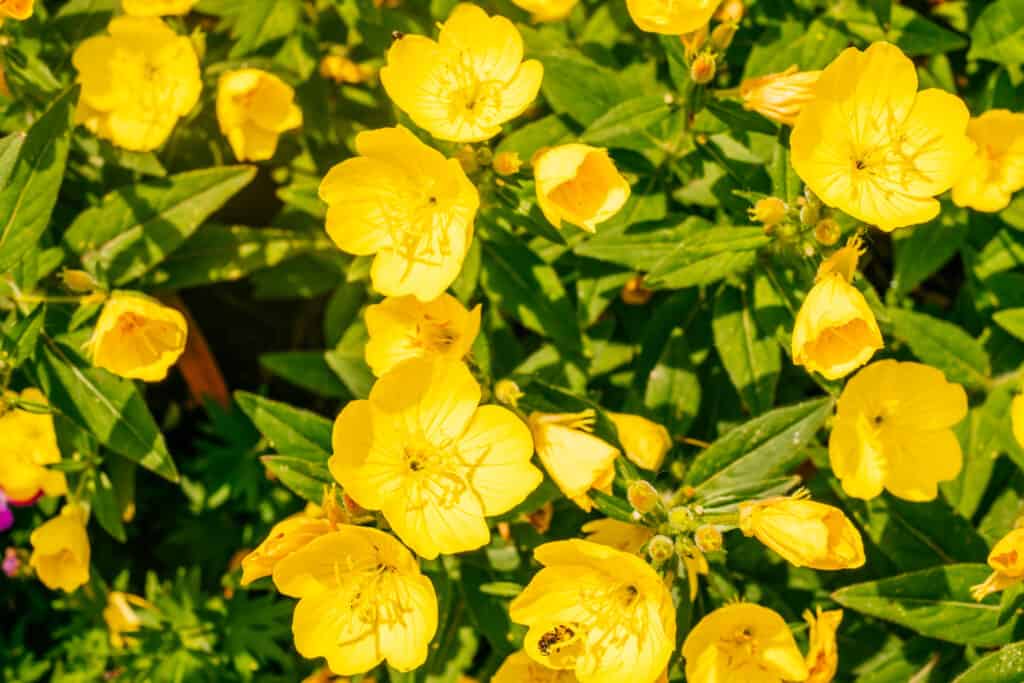
As evidenced by its name, the evening primrose blooms in the night.
©iStock.com/Christina Vartanova
The evening primrose carries symbolic meanings of fickleness or faithlessness but also represents sweet memories.
Its flowers feature four lemon yellow petals, accompanied by four sepals, eight stamens, and a distinct style with a cross-shaped stigma. The bowl-shaped petals form enchanting blooms. Interestingly, these blossoms unfurl in the evening, remaining open throughout the night and closing during the heat of the day, hence its common name.
From early summer to early fall, the evening primrose blankets the landscape.
11. Eyebright (Euphrasia)
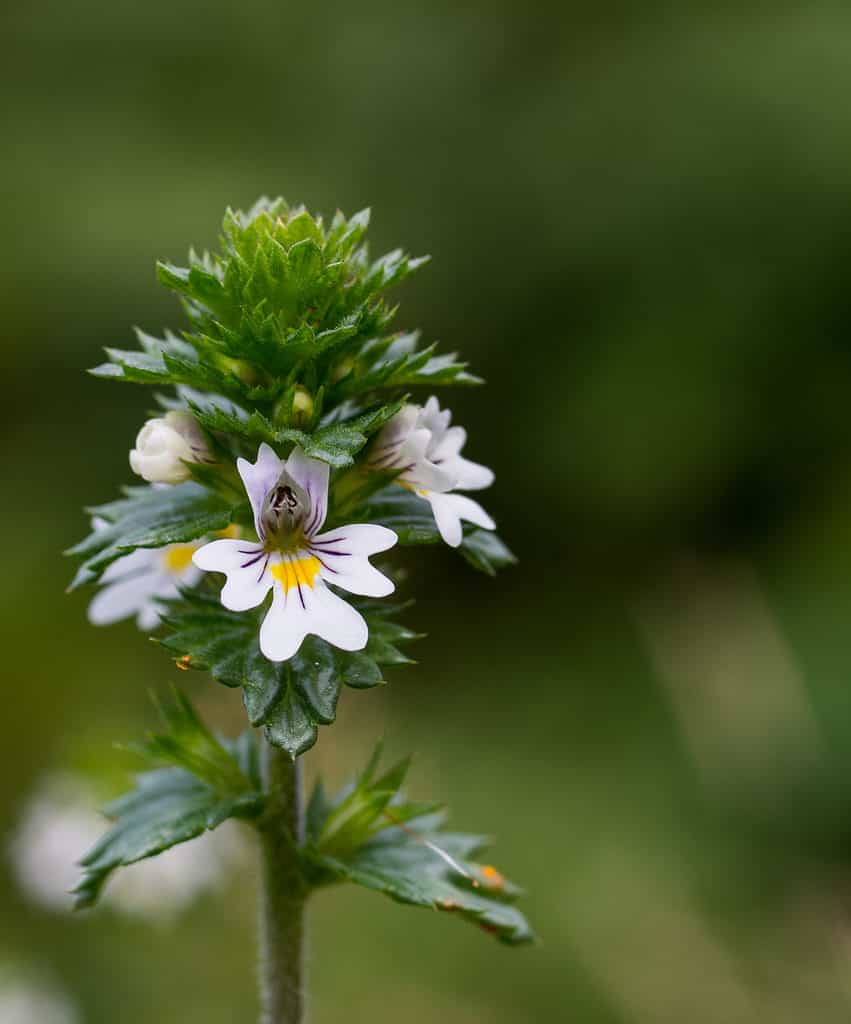
The eyebright blooms from July to August.
©Pavel_Voitukovic/Shutterstock.com
According to Greek mythology, eyebright possesses remarkable properties for treating eye ailments.
This petite flower boasts delicate white petals adorned with intricate purple veins and vibrant yellow centers. Thriving in diverse landscapes, from clifftops to heaths, eyebright is part of a group of species and hybrids that are difficult to distinguish from one another.
With its charming appearance, this flower blooms from July to August and sometimes extends into September.
12. Eastern Purple Coneflower (Echinacea purpurea)
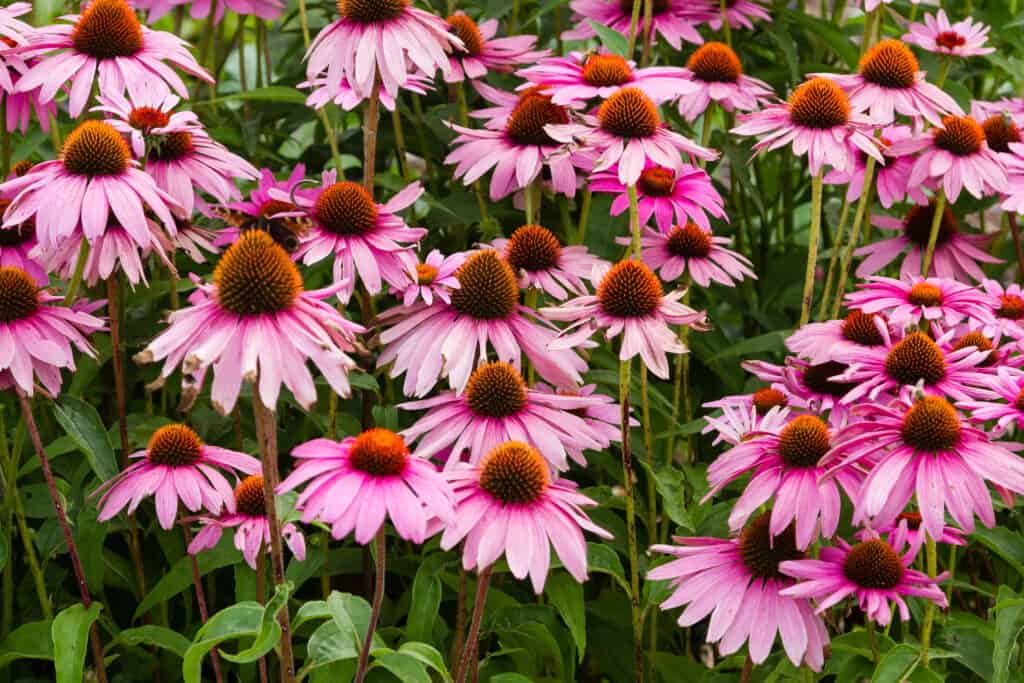
With a history as a medicinal plant, the eastern purple coneflower provides relief for coughs, colds, and sore throats.
©Milosz Maslanka/Shutterstock.com
The eastern purple coneflower held great significance as a medicinal plant among Native Americans, who utilized its healing properties for various ailments. Renowned for its pain-relieving and anti-inflammatory qualities, it subsequently provided relief for coughs, colds, toothaches, and sore throats.
This flower has striking lavender petals that surround a spiny, dome-shaped center in shades of orange or brown. Furthermore, this coneflower’s stems are adorned with small, rough hairs.
Its splendid flowers grace the landscape in early summer, generally blooming from June to July.
13. Evening Stock (Matthiola longipetala)
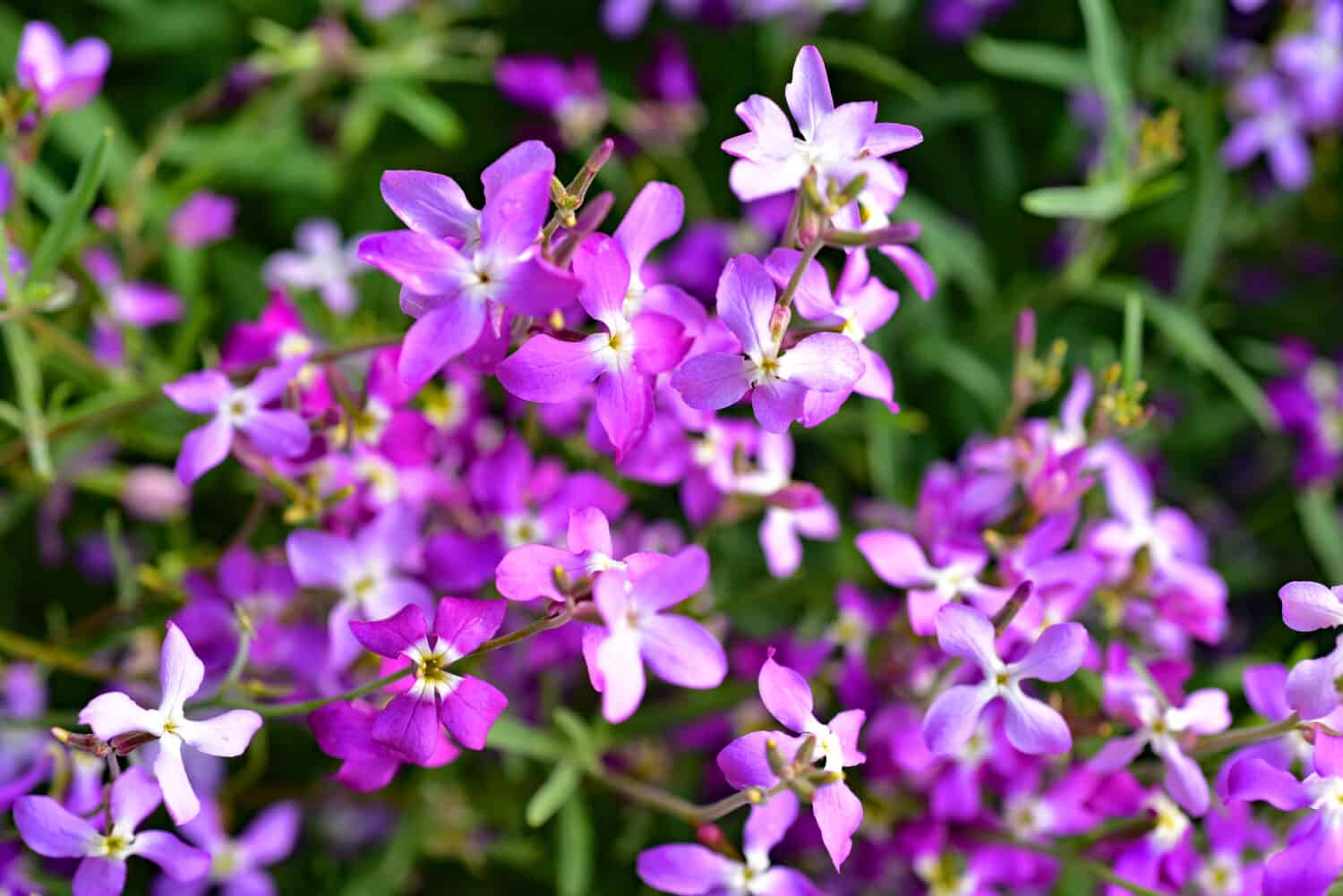
Originating from the Mediterranean, the evening stock flower attracts moths.
©Nature1000/Shutterstock.com
The stock flower represents a joyous and contented life and originates from Southwestern Greece and the Mediterranean region.
This flower has simple, four-petaled blooms in white, lilac, or pink hues. Additionally, with its slender gray-green stems and accompanied by long, narrow leaves, these flowers emit a strong and delightful perfume, attracting night-flying moths. They thrive in both border plantings and pots and can be easily cut for captivating indoor floral arrangements.
The stock flower blooms from late spring to mid-summer, bringing about 4 to 6 weeks of beauty and charm to gardens and displays.
14. Everlasting Pea (Lathyrus latifolius)

Surprisingly, everlasting peas do not have a scent.
©Dana.S/Shutterstock.com
With their upright and clustered flowers, everlasting peas symbolize good wishes, friendship, kindness, and farewells.
Short clusters of 4-10 flowers occasionally emerge from the leaf axils. Each flower, measuring about ¾ to 1″ across, looks like a pea, featuring an upper standard and a lower keel surrounded by lateral petals. The petals of this purplish-pink flower fade as they age and do not have any scent.
The everlasting pea blooms throughout the summer for approximately 2 months.
15. Elephant’s Ear (Colocasia)

Although primarily cultivated for its leaves,
elephant
ears bloom occasionally too.
©komkrit Preechachanwate/Shutterstock.com
Elephant ears, primarily cultivated for their striking foliage, can occasionally produce blooms, although uncommon in the Midwest region. Surprisingly, the flowers of elephant ears bear a resemblance to those of canna lilies.
To cultivate elephant ears, it is best to plant them in the spring after the last frost. Their flowering period generally spans from late spring to early fall.
16. Exotic Emperor (Tulipa fosteriana)
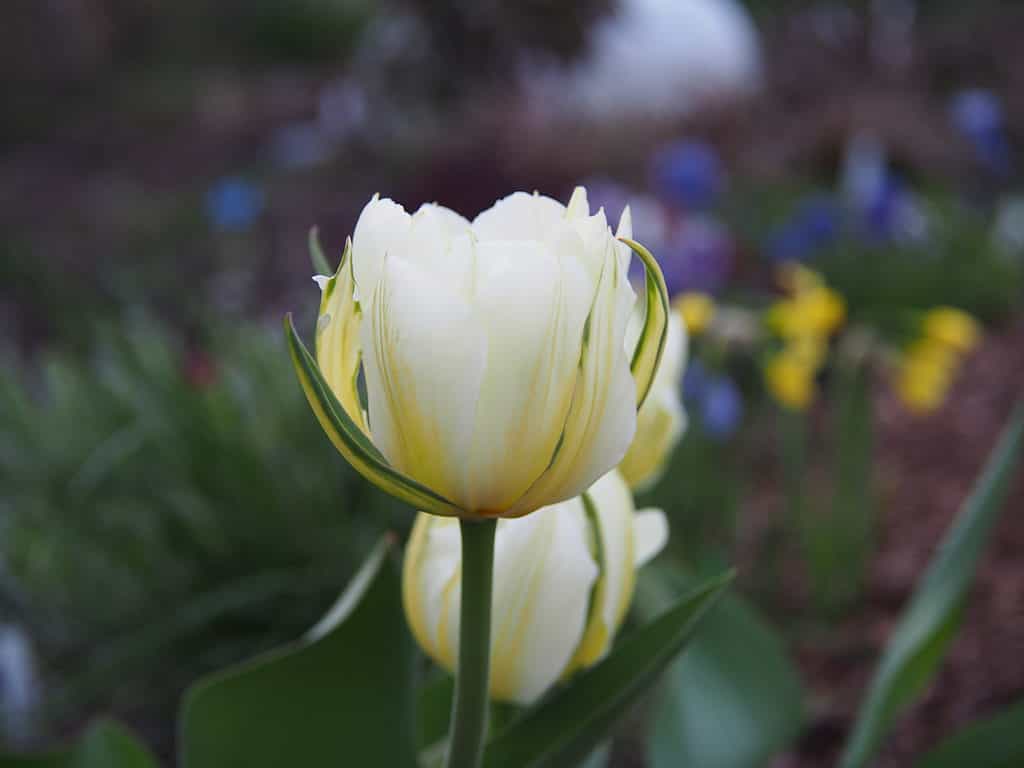
The Exotic Emperor tulip almost resemble peonies.
©Anna Gratys/Shutterstock.com
Introducing the gorgeous tulip ‘Exotic Emperor,’ a recent addition that blooms in early spring.
Its large, double flowers, resembling fluffy white peonies, also boast delicate green and cream framed accents. This tulip is also known for its robust stems, reliable performance, and early blooming nature. Planted en masse, the exotic emperor creates an impressive display, evoking a sense of grandeur.
Blooming in early to mid-spring, this tulip effortlessly naturalizes, returning year after year.
17. Evening Trumpet Flower (Gelsemium sempervirens)
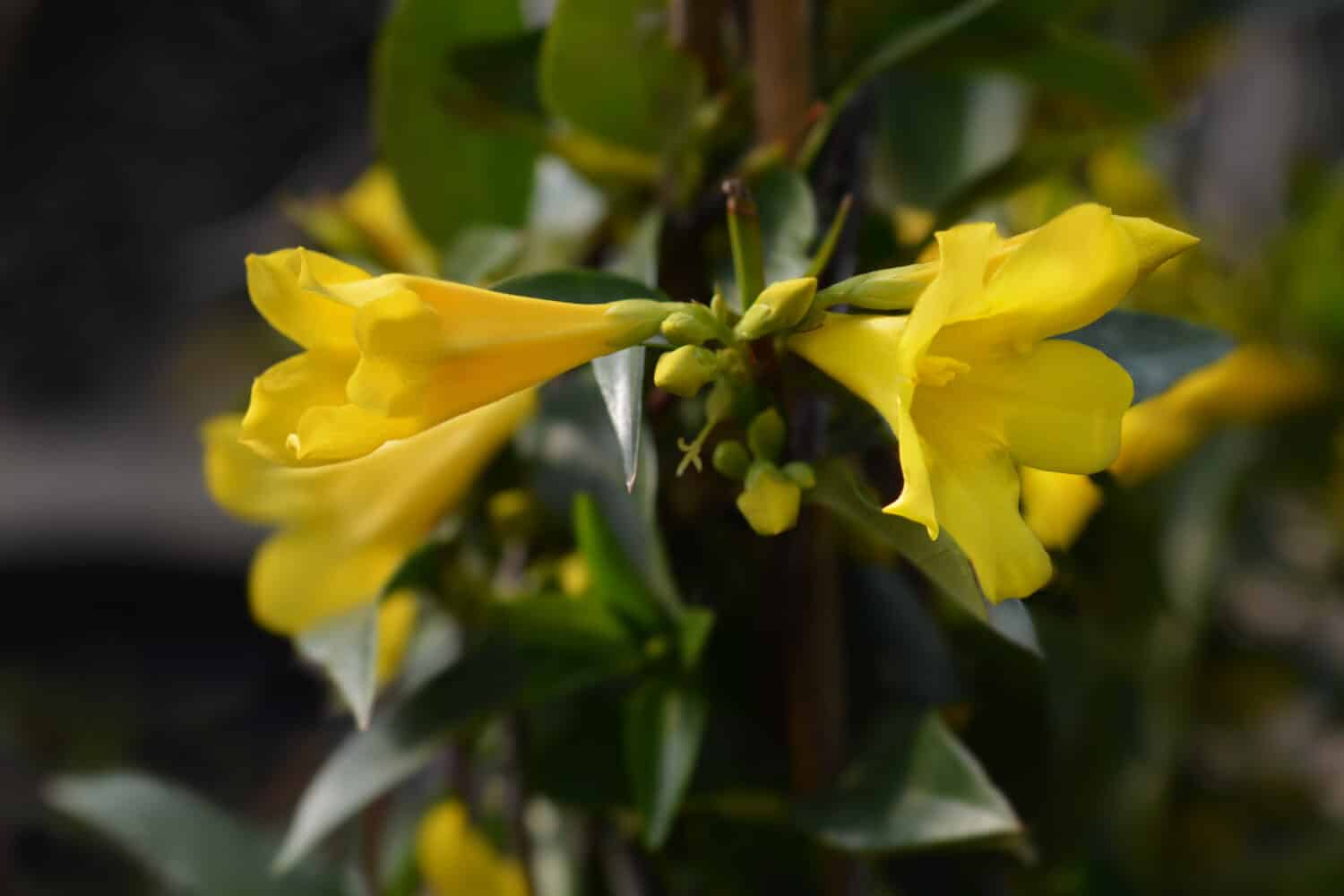
Although beautiful, the evening trumpet flower is toxic.
©Nahhana/Shutterstock.com
The evening trumpet flower, with its vibrant yellow hue, symbolizes joy, happiness, and positivity. This remarkable plant has also been honored with the esteemed Award of Garden Merit by the Royal Horticultural Society.
Its blossoms, often found in clusters, may feature orange markings in the throat. Furthermore, these gorgeous flowers attract bees, hummingbirds, and butterflies, which makes it a perfect choice for those wanting to attract these pollinators to their garden. During winter, the dense foliage may have a subtle purple or yellow tinge. Unfortunately, it’s important to note that all parts of the plant are toxic.
Blooming from late winter to early spring, they may surprise you with sporadic blooms during the fall.
18. Evergreen Clematis (Clematis vitalba)
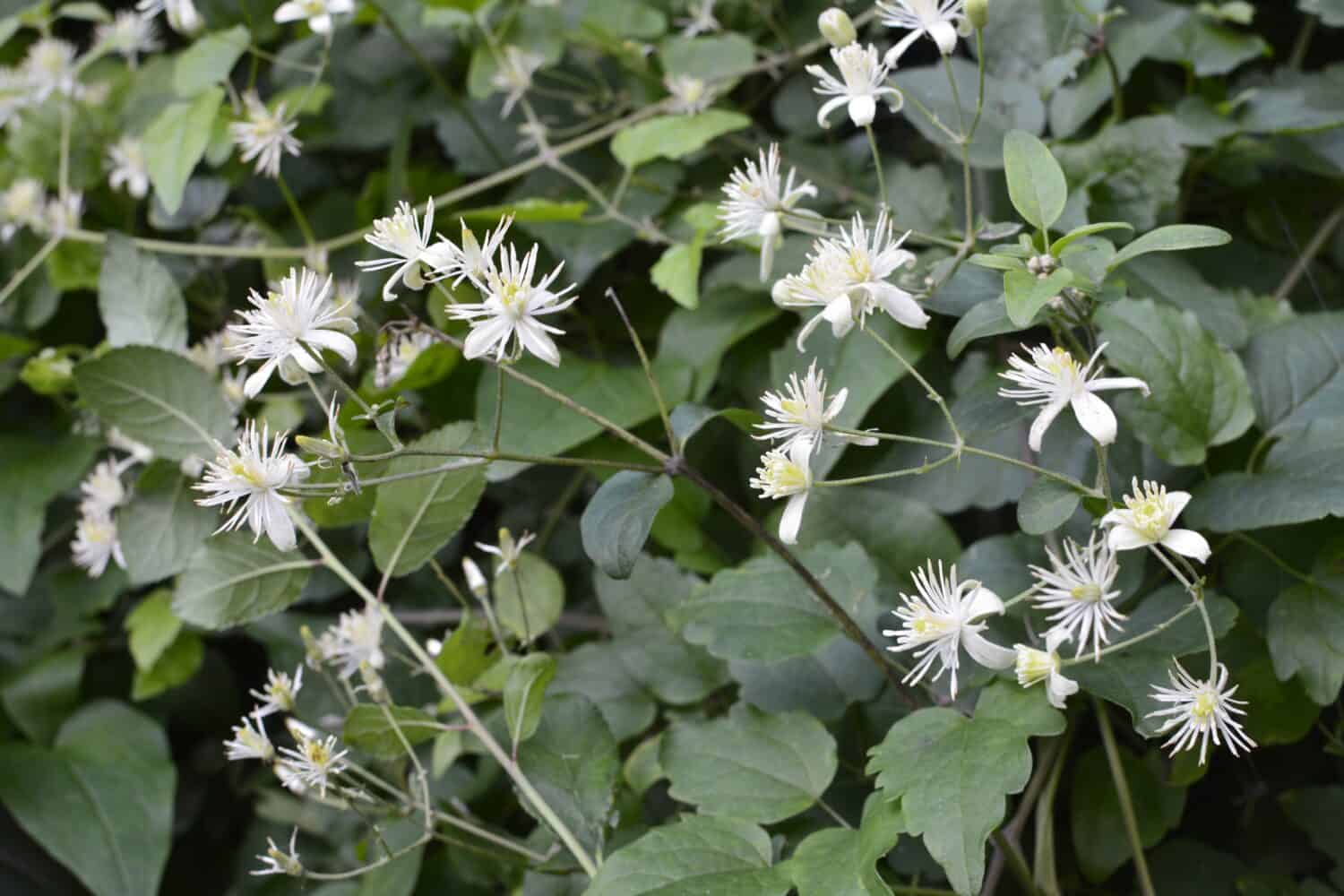
Evergreen clematis are climbers.
©weha/Shutterstock.com
In Japan, the clematis represents “moral beauty” and “the joy of a traveler.”
These evergreen climbers bear an abundance of small, single flowers, predominantly in white or creamy-white shades. Additionally, evergreen clematis captivates with their extensive flowering duration, diverse flower shapes, and a wide array of colors, making them a popular choice among gardeners.
These flowers bloom generously from mid-winter, starting in January and continuing through March to April.
19. Exeter Passion Flower (Passiflora × exoniensis)
Exeter passion flower, a hybrid cultivated by horticultural experts, showcases remarkable vigor as a self-fertilizing climber, capable of reaching heights of 13 to 20 feet.
As the queen of summer, it graces gardens with its large and exotic flowers measuring up to 4-5 inches. Additionally, these blooms capture attention with their intriguing shape. Adorned with evergreen foliage and equipped with tendrils, this plant clings to its support.
During July and August, an abundance of dark pink, pendulous tube-shaped flowers emerges, gradually lightening to a delicate pink hue accompanied by long stamens.
20. Egret Flower (Pecteilis radiata)

A beautiful orchid, the egret flower is another gorgeous flower that starts with E.
©iStock.com/magicflute002
The egret flower, native to Asia, is a terrestrial orchid known for its growth from fleshy, pea-sized tubers. Unfortunately, this flower is endangered in its natural habitat, facing threats from habitat destruction, urbanization, and overcollection.
The egret flower has deep green, strappy leaves and produces exquisite blossoms that resemble graceful white birds in mid-flight. These flowers also have two large, intricately fringed petals spread outwards, accompanied by a central elongated petal pointing forward.
Blooming for four weeks in late summer, these blossoms boast upright, unbranched stalks, each capable of bearing up to eight of these flowers.
Comprehensive List of All Flowers That Start With E
- Easter Lily (Lilium longiflorum)
- Edelweiss (Leontopodium nivale)
- Egyptian Star Cluster (Pentas lanceolata)
- Eglantine Rose (Rosa rubiginosa)
- English Bluebell (Hyacinthoides non-scripta)
- English Daisy (Bellis perennis)
- English Lavender (Lavandula angustifolia)
- English Marigold (Calendula officinalis)
- English Primrose (Primula vulgaris)
- Evening Primrose (Oenothera biennis)
- Eyebright (Euphrasia)
- Eastern Purple Coneflower (Echinacea purpurea)
- Evening Stock (Matthiola longipetala)
- Everlasting Pea (Lathyrus latifolius)
- Elephant’s Ear (Colocasia)
- Exotic Emperor (Tulipa fosteriana)
- Evening Trumpet Flower (Gelsemium sempervirens)
- Evergreen Clematis (Clematis vitalba)
- Exeter Passion Flower (Passiflora x exoniensis)
- Egret Flower (Pecteilis radiata)
- Everlasting daisy (Xerochrysum bracteatum)
- Elecampane (Inula helenium)
- Enchanter’s nightshade (Circaea lutetiana)
- Eryngo (Eryngium sp.)
- Eve’s needle (Austrocylindropuntia subulata)
- Ear-leaved tickseed (Coreopsis auriculata)
- Empire blue butterfly bush (Buddleja davidii ‘Empire Blue’)
- Early goldenrod (Solidago gigantea)
- Early meadow rue (Thalictrum dioicum)
- Eastern round-leaved violet (Viola rotundifolia)
- Electrode cactus (Ferocactus Hystrix)
- Eastern bluestar (Amsonia tabernaemontana)
- Eastern red columbine (Aquilegia canadensis L.)
- Eastern redbud (Cercis canadensis)
- Elephant bush (Portulacaria afra)
- Emerald blue creeping phlox (Phlox subulata)
Summary of Flowers That Start With E
| Flower | Botanical Name |
|---|---|
| Easter Lily | Lilium longiflorum |
| Edelweiss | Leontopodium nivale |
| Egyptian Star Cluster | Pentas lanceolata |
| Eglantine Rose | Rosa rubiginosa |
| English Bluebell | Hyacinthoides non-scripta |
| English Daisy | Bellis perennis |
| English Lavender | Lavandula angustifolia |
| English Marigold | Calendula officinalis |
| English Primrose | Primula vulgaris |
| Evening Primrose | Oenothera biennis |
| Eyebright | Euphrasia |
| Eastern Purple Coneflower | Echinacea purpurea |
| Evening Stock | Matthiola longipetala |
| Everlasting Pea | Lathyrus latifolius |
| Elephant’s Ear | Colocasia |
| Exotic Emperor | Tulipa fosteriana |
| Evening Trumpet Flower | Gelsemium sempervirens |
| Evergreen Clematis | Clematis vitalba |
| Exeter Passion Flower | Passiflora x exoniensis |
| Egret Flower | Pecteilis radiata |
Thank you for reading! Have some feedback for us? Contact the AZ Animals editorial team.







